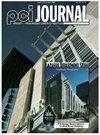Investigation of measured prestress losses compared with design prestress losses in AASHTO Types II, III, IV, and VI bridge girders
IF 0.9
4区 工程技术
Q4 CONSTRUCTION & BUILDING TECHNOLOGY
引用次数: 2
Abstract
Inaccurate prediction of prestress losses leads to inaccurate predictions for camber, deflection, and concrete stresses in a bridge girder. This study aims to improve the prediction of prestress losses and provides bridge designers with insights into the differences between design and actual concrete properties. Prestress losses, compressive strength, modulus of elasticity, shrinkage, and creep were measured for several American Association of State Highway and Transportation Officials (AASHTO) Types II, III, IV, and VI girders. The investigation revealed that the measured total prestress losses at the time of deck placement were lower than the design losses calculated using the refined estimates method of the 2017 AASHTO LRFD Bridge Design Specifications. This was mainly attributed to the actual concrete compressive strength at transfer being greater than the design compressive strength. This discrepancy was as high as 73% for some girders. It was also determined that the 2017 AASHTO LRFD specifications’ refined estimates method for estimating prestress losses overestimates the total prestress losses at the time of deck placement for AASHTO Types II and III girders.AASHTO II型、III型、IV型和VI型桥梁梁中实测预应力损失与设计预应力损失的对比研究
对预应力损失的不准确预测会导致对桥梁主梁的弧度、挠度和混凝土应力的不准确预测。本研究旨在改善预应力损失的预测,并为桥梁设计师提供设计和实际混凝土性能之间差异的见解。预应力损失、抗压强度、弹性模量、收缩和蠕变测量了几种美国国家公路和运输官员协会(AASHTO) II、III、IV和VI型梁。调查显示,在甲板铺设时测量的总预应力损失低于使用2017年AASHTO LRFD桥梁设计规范的改进估计方法计算的设计损失。这主要是由于混凝土在转移时的实际抗压强度大于设计抗压强度。对于某些梁,这种差异高达73%。此外,2017年AASHTO LRFD规范中估算预应力损失的精确估算方法高估了AASHTO II型和III型梁在甲板放置时的总预应力损失。
本文章由计算机程序翻译,如有差异,请以英文原文为准。
求助全文
约1分钟内获得全文
求助全文

 求助内容:
求助内容: 应助结果提醒方式:
应助结果提醒方式:


